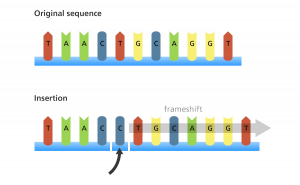Description
Mistakes occasionally do occur spontaneously during DNA replication, causing changes in the sequence of nucleotides. Such changes, or mutations, also can arise from radiation that causes damage to the nucleotide chain or from chemical poisons, such as those in cigarette smoke, that lead to errors during the DNA-copying process. Mutations come in various forms: a simple swap of one nucleotide for another; the deletion, insertion, or inversion of one to millions of nucleotides in the DNA of one chromosome; and translocation of a stretch of DNA from one chromosome to another.
Mutated genes that encode altered proteins or that cannot be controlled properly cause numerous inherited diseases. For example, sickle cell disease is attributable to a single nucleotide substitution in the haemoglobin gene, which encodes the protein that carries oxygen in red blood cells. The single amino acid change caused by the sickle cell mutation reduces the ability of red blood cells to carry oxygen from the lungs to the tissues. Recent advances in detecting disease-causing mutations and in understanding how they affect cell functions offer exciting possibilities for reducing their often devastating effects.
What types of genetic variants are possible?
The DNA sequence of a gene can be altered in various ways. Genetic variants (also known as Addition and Deletion Mutations) can have a variety of health effects, depending on where they occur and whether they alter the function of essential proteins. Variant types include the following:
1. Substitution
This type of variant replaces one DNA building block (nucleotide) with another. Substitutional variants can be further classified by the effect they have on protein production from the altered gene.
- Missense: A missense variant is a type of substitution in which the nucleotide change results in the replacement of one protein building block (amino acid) with another in the protein made from the gene. The amino acid change can alter the function of the protein.
- Nonsense: A nonsense variant is another type of substitution. However, instead of causing an amino acid change, the altered DNA sequence results in a stop signal that prematurely tells the cell to stop building a protein. This type of variant results in a shortened protein that can malfunction, not work, or break down.
2. Insertion
An insertion changes the DNA sequence by adding one or more nucleotides to the gene. As a result, the protein made from the gene may not work properly.

3. Suppression
A deletion changes the DNA sequence by removing at least one nucleotide in a gene. Small deletions remove one or a few nucleotides within a gene, while larger deletions can remove an entire gene or several neighbouring genes. The removed DNA can alter the function of the affected protein(s).
4. Delete-Insert
This variant occurs when a deletion and an insertion occur at the same time at the same location in the gene. In a deletion-insertion variant, at least one nucleotide is removed and at least one nucleotide is inserted. However, the change must be complex enough to differ from a simple substitution. The resulting protein may not work properly. An insertion-deletion variant (dealings) may also be known as an insertion-deletion variant (indel).
5. Duplication
Duplication occurs when a stretch of one or more nucleotides in a gene is copied and repeated along with the original DNA sequence. This type of variant can alter the function of the protein made from the gene.
6. Investment
An inversion changes more than one nucleotide in a gene by replacing the original sequence with the same sequence in reverse order.
7. Frame change
A reading frame consists of groups of three nucleotides that each code for an amino acid. A frameshift variant occurs when there is an addition or loss of nucleotides that changes the grouping and changes the code for all subsequent amino acids. The resulting protein is usually nonfunctional. Insertions, deletions, and duplications can be frameshift variants.
8. Repeat expansion
Some regions of DNA contain short sequences of nucleotides that are repeated several times in a row. For example, a trinucleotide repeat is made up of sequences of three nucleotides and a tetranucleotide repeat is made up of sequences of four nucleotides. A repeat expansion is a variant that increases the number of times the short DNA sequence is repeated. This type of variant can cause the resulting protein to not work properly.

